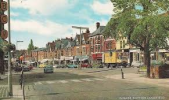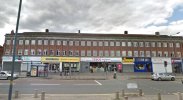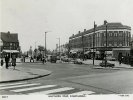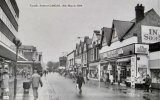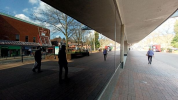According to Historic England shopping parades:
“ are purpose-built rows of shops, often with generous residential accommodation above. They were built in large numbers, and with increasing architectural elaboration, from the mid-nineteenth century. Parades often comprised the commercial centre of suburban and dormitory communities, but were built on main thoroughfares, close to railway stations or tram or omnibus termini, where they might attract passing traffic as well as local shoppers. From the 1880s parades adopted a plethora of historicist styles: neo-Tudor, neo-Baroque, Queen Anne and a restrained neo-Georgian. The last predominated in the inter-war years, which might be regarded as the heyday of the shopping parade”.
Many still survive as rows of shops with accommodation above. Let’s record those around Birmingham, especially ones with original features intact.
To get us started, this is a nice example from 1914 on the Soho Road. Viv.

“ are purpose-built rows of shops, often with generous residential accommodation above. They were built in large numbers, and with increasing architectural elaboration, from the mid-nineteenth century. Parades often comprised the commercial centre of suburban and dormitory communities, but were built on main thoroughfares, close to railway stations or tram or omnibus termini, where they might attract passing traffic as well as local shoppers. From the 1880s parades adopted a plethora of historicist styles: neo-Tudor, neo-Baroque, Queen Anne and a restrained neo-Georgian. The last predominated in the inter-war years, which might be regarded as the heyday of the shopping parade”.
Many still survive as rows of shops with accommodation above. Let’s record those around Birmingham, especially ones with original features intact.
To get us started, this is a nice example from 1914 on the Soho Road. Viv.



